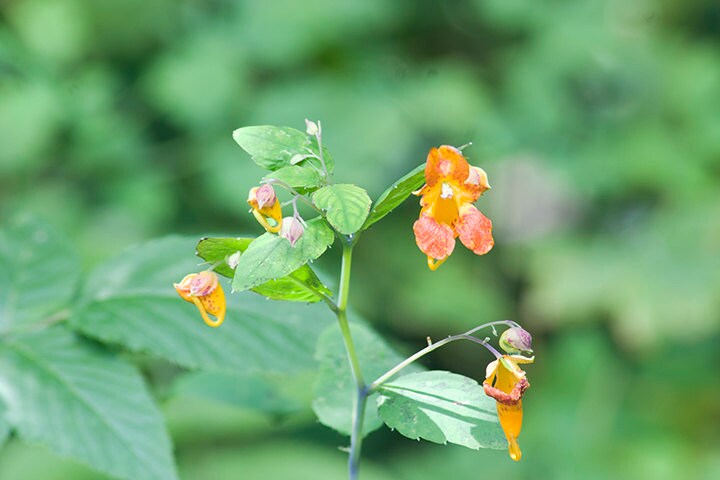If anyone didn't see the post on How to Make Herbal Oils, it's linked here.
Making salve is an ancient practice. Salves are a wonderful method for administering some herbal preparations through touch - one of the oldest healing modalities known to man.
What is a Salve
Technically, a salve is simply an oil preparation that has been made thicker, and easier to apply with it running and making a big mess. One of the simplest ways to do that is to use an emulsifying wax in your oil. When it cools, the oil will be thicker, and easier to apply.
What is Salve Used for?
Salves are used for everything from skin conditions like rashes and dryness, to irritation like diaper rash, to pain relief for conditions like rheumatism or arthritis.
Why use Salve instead of Essential Oil
While (diluted) essential oils make a powerful treatment (see last week's post on making essential oil remedies for pain), the one thing that super charges them is the addition of herbs! Herbal oils can have a very powerful healing action. This action is typically a bit slower than traditional medicines, but it goes deep and works real healing rather than just masking symptoms.
The Best Salve of All
I would be hard pressed to say which is better - essential oils or herbal oils. They are both so wonderful in their own way. The good news is, you don't have to choose! The actions of these botanical ingredients is wonderful together! Most of my standby home remedies that my family relies on are made of a mix of BOTH essential oils and herbal oils.Once you have herbal oils made, there is no reason you can't combine a few different types together, make a salve, then add some essential oils when you put the finished product in jars. The results can be magic!
Instructions for Making Salve
To make a basic salve, you'll need:
- 1 Cup Herbal Oil (or a mix of herbal oils)
- 1 Oz Grated Emulsifying Wax (I typically use ethically harvested beeswax)
- 1 Teaspoon Pure Vitamin E
In a double boiler on the stove, pour the oil and add your grated/shredded wax. Warm it gently until the wax is melted. TestThe test for salve is as follows:
- Stir the melted wax and oil with a spoon.
- Shake the spoon off over the double boiler so it is barely coated.
- Put the spoon in the freezer for a few minutes to cool completely.
Some liquid from the oil/wax will have pooled slightly on the spoon. Press your finger into that (now solidified) pool. If the texture feels good, you are done! If it's stiffer than you'd like, add a tablespoon of oil. If it's too thin and runny, add a tablespoon of grated wax. Either way, repeat the test until you have a consistency you like.
Additives: Preservatives & Essential Oils
Preservative: Once your salve is at the proper consistency, you can take it off the heat, and add the vitamin E. Vitamin E is a natural preservative for oil ingredients, that will help prevent mold. This should be plenty of preservative for home use. I never add anything else to items my family uses. If you wish to sell your salve, you will have to investigate preservative options. They are beyond the scope of this post.you can get the type of Vitamin E I am referring to at Mountain Rose Herbs (that's where I get mine). I am sure others sell it - just don't use the drug store stuff. That is different and will not act as a preservative. You can open capsule of the vitamin E supplements, although I am not sure how many equate to the recipe I am using.
Essential Oils: Once the salve is somewhat cooled and has the vitamin E added, it's time to add any essential oils. Remember not to use too heavy a hand here! A little goes a long way. Think drops rather than larger quantities.
There is a terrific chart in Valerie Warwood's Guide to Essential Oils that I refer to all the time. It's a fabulous reference book for anyone who wants to pursue this type of home remedy making.
Recipes
As always, the following are just some combinations to try. The joy of this type of work is finding the perfect combination for you and your loved ones. The following are a few from my family.
Arthritis Rub
- 1/3 Cup White Willow Herbal Oil
- 1/3 Cup Meadowsweet Herbal Oil
- 1/3 Cup Arnica Herbal Oil
- 1 Oz Beeswax, grated (or more if desired)
- 1 teaspoon pure Vitamin E
- 1 teaspoon of essential oil, combined, maximum
- 1/4 tsp Clove
- 1/4 tsp Ginger
- 1/4 tsp Cedar wood
- 1/8 tsp Lavender
- 1/8 tsp Eucalyptus globulous
For ideas on which oils to use, check out the list in the post on Using Essential Oils for Pain.
Muscle Aches
- 1/2 Cup Arnica Herbal Oil
- 1/2 Cup St. John's Wort Herbal Oil
- 1 Oz Beeswax, grated (or more if desired)
- 1 teaspoon pure Vitamin E
- 1 teaspoon of essential oil, combined, maximum
- 1/4 tsp clove
- 1/4 tsp peppermint
- 1/4 tsp Frankincense
- 1/4 tsp Helichrysum
Add the essentials after removing the salve from the heat, just as you pour it into jars.The warm salve will get hard to manipulate as it cools. It will get thick and require spooning into containers if you wait too long. I generally pour it into jars, then add the essential oil to the jars and seal it, then gently shake to mix and leave it to cool.If you try something different and want to share, I encourage you to share it here. I hope this will become a place for many of us to grow and learn together.
Bright Blessings!
Alison
